#suborbital spaceflight
Text


VSS Unity | Eric Berger
42 notes
·
View notes
Photo

2023 August 3
The Falcon and the Redstone
Image Credit & Copyright: Matt Haskell
Explanation: In a photo from the early hours of July 29 (UTC), a Redstone rocket and Mercury capsule are on display at Cape Canaveral Launch Complex 5. Beyond the Redstone, the 8 minute long exposure has captured the arcing launch streak of a SpaceX Falcon Heavy rocket. The Falcon's heavy communications satellite payload, at a record setting 9 metric tons, is bound for geosynchronous orbit some 22,000 miles above planet Earth. The historic launch of a Redstone rocket carried astronaut Alan Shepard on a suborbital spaceflight in May 1961 to an altitude of about 116 miles. Near the top of the frame, this Falcon rocket's two reusable side boosters separate and execute brief entry burns. They returned to land side by side at Canaveral's Landing Zone 1 and 2 in the distance.
∞ Source: apod.nasa.gov/apod/ap230803.html
55 notes
·
View notes
Text

Compact robot takes flight to support CERISS initiative
A new robot will be taking flight soon to test its ability to support biological and physical science experiments in microgravity. As one of NASA's 2023 TechFlights selections, this compact robot will have a chance to fly on a commercial suborbital flight to see just how well it can perform in a space environment.
Managed by NASA's Flight Opportunities program, the TechFlights 2023 solicitation included a call for technologies to support the agency's Commercially Enabled Rapid Space Science (CERISS) initiative. CERISS, administered by NASA's Biological and Physical Sciences Division, uses the spaceflight environment to study phenomena in ways that cannot be done on Earth.
One of the 11 TechFlights selections that will undergo flight testing is a compact robot designed to prepare samples for science experiments in microgravity, improve in-flight sample preparation capabilities and potentially reduce astronauts' time tending to such research while on the International Space Station or future commercial destinations in low Earth orbit.
Led by principal investigator Phil Putman, manager of advanced projects at Sierra Lobo, Inc, in Fremont, Ohio, the tests will leverage parabolic flights from Zero Gravity Corporation to evaluate the technology's performance in microgravity.
"We need transformative capabilities to conduct research in space as NASA continues its exploration mission," said BPS division director Lisa Carnell. "The commercial testing supported by Flight Opportunities will help CERISS advance a key research spaceflight innovation with the goal of improving in-flight sample analysis and advancing our study of biological and physical systems in space."
CERISS aims to advance biological and physical research capabilities with the commercial space industry, including sample preparation and analysis technologies for use in microgravity. The project's long-term goals include conducting scientist astronaut missions on commercial space stations as well as developing automated hardware for experiments beyond low Earth orbit, such as on the lunar surface. Benefits include an increase in the pace of research for a wide range of research leading to an increased demand for research and development in low Earth orbit, facilitating growth of the commercial space industry.
11 notes
·
View notes
Text
To the bottom of the sea and the ends of the earth, high-risk travel is booming.
Re: the missing Titanic tourist submersible, from Christine Chung for The New York Times:
Plunging to the depths of the ocean in a submersible to explore the remains of the Titanic is just one of many extreme excursions on offer for travelers willing to pay a hefty price tag — and accept a substantial dose of peril...
These types of singular and dangerous adventures are becoming increasingly popular with deep-pocketed leisure travelers in search of novel experiences, several travel experts said.
“There are a lot of incredibly well-traveled folks out there who constantly push the boundaries of their travels to chase thrills and claim bragging rights,” said Peter Anderson, managing director of Knightsbridge Circle, a luxury concierge service with offices in London, New York and Dubai. “They’re so accustomed to what they consider to be typical vacations that they begin to seek out more unique experiences, many of which involve a degree of risk.”
Mr. Anderson said he had recently planned a trip for a client to visit the pyramids in South Sudan, the site of one of the world’s biggest refugee crises, which has a “Do Not Travel” advisory from the U.S. State Department. The planning process, he said, involved consultations with security experts on how to best mitigate potential dangers.
Another client wanted to voyage to the geographic South Pole — the southernmost point on Earth — which required chartering an icebreaker, a large vessel that can pass through ice-covered waters, and two helicopters for sightseeing. The trip, which cost about $100,000 per person, required a week of various health screenings and weather preparedness training.
Physically demanding expeditions to some of the world’s most remote destinations are a growing business for the luxury travel company Abercrombie & Kent, said Geoffrey Kent, its founder. He said the company uses expert guides to eliminate as much risk as possible.
“These are thrilling adventures for top-tier clients who have done pretty much everything,” Mr. Kent said in a statement, adding that the challenges left guests “with a sense of accomplishment.”
Perhaps the priciest ticket, and biggest possible risk, is space travel, which has been dominated by a trio of billionaire-led rocket companies: Blue Origin, owned by Jeff Bezos, whose passengers have included the “Star Trek” television star William Shatner; Richard Branson’s Virgin Galactic, where tickets for a suborbital spaceflight start at $450,000; and Elon Musk’s SpaceX, which in 2022 launched an all-civilian spaceflight, with no trained astronauts on board.
#people so rich they've got nothing to do but die#OceanGate#Titan submersible#the world is so fucked#the fact that people with this kind of money spend it on near death experiences#imagine being so rich you can't enjoy a vacation if it doesn't involve a brush with death
17 notes
·
View notes
Text
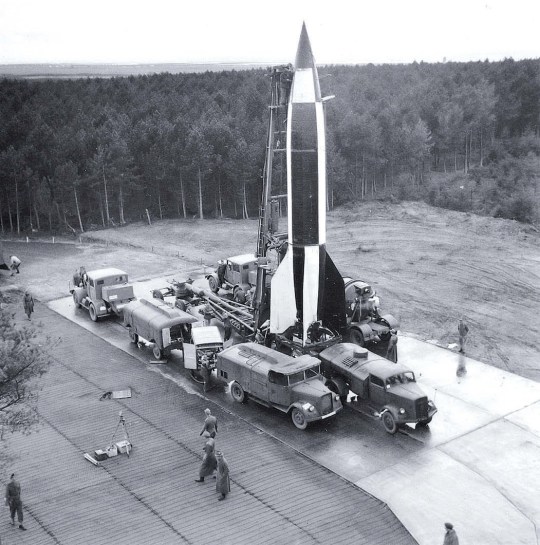
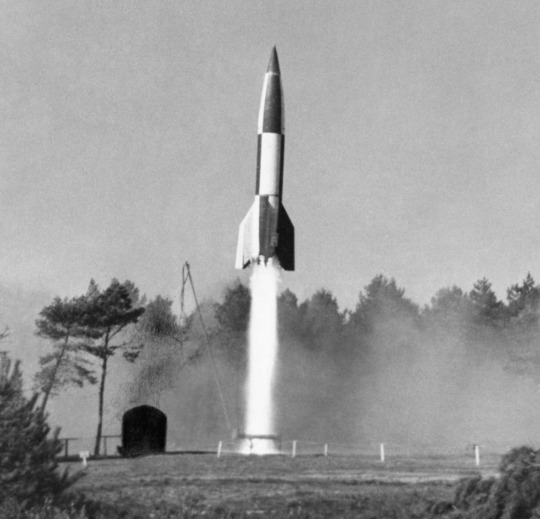

October 2, 1945: The first V-2 launches under Operation Backfire
Operation Backfire was a post-World War II British project that launched captured V-2 rockets over the North Sea. The three flights were highly successful and served as inspiration for Megaroc. Megaroc was a manned V-2 derivative proposed by the British Interplanetary Society. It was similar to NASA's Project Mercury as both were civilian projects aimed at sending a man on a suborbital spaceflight using modified pre-existing technology.
Read more about Operation Backfire and the Megaroc here!
10 notes
·
View notes
Text
I wonder how much the loss of the Aethers set back the Arcane space program?
Fact 1: Arcane Flight had the technology to create a self-sustaining, vacuum-proof spaceship (fight me staff i have the pedantry to back up my word choice) in the time of the Aethers.
Fact 2: There's no evidence that Arcane Flight tried to go to space after that, or even build another suborbital observatory, even though the technology existed. We're the spaceflight flight, and also the "so preoccupied with if we can that we don't stop to think if we should" flight, so you'd think that if we could send people to space we'd be doing it constantly.
Fact 3: The Arcanist must not have known the Aethers survived. If they were sending back data--which, I can't see how that wouldn't have been the plan--then there would be no reason to hide the source from the younger Arcane dragons, so they must have lost contact with the Observatory when they yeeted themselves into orbit.
The Arcanist was obviously planning for them to survive long-term, or he wouldn't have set them up with a habitat capable of indefinite life support. And if he'd thought they were still alive out there, surely he'd have tried to find a way to reach them, for the data if nothing else.
So: How must he have felt when they went missing? Guilty? Sad? Devastated, even?
Devastated enough to indefinitely delay space travel lest it claim more of his children?
#if canon won't give me any spacedad angst then i'll make it myself#flight rising#fr headcanon#fr aether#the arcanist#anyway now i'm gonna go do the dragon a day drawing i've been putting off for hours
22 notes
·
View notes
Text
Space Tech: Private Ventures and Mars Exploration
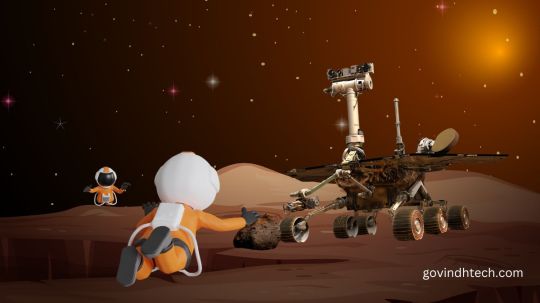
Space Tech
Beyond intrepid exploration, space technology has advanced to address pressing issues on Earth. It is becoming more and more essential to the effective operation of contemporary societies and their economic growth. Space has the potential to directly affect billions of people’s lives and open up large-scale, highly impactful solutions.
A broad term for satellites, space stations, ground stations, tracking and monitoring centers, downstream analytics and artificial intelligence, software, and other technologies, SpaceTech offers innovative ways to solve global concerns. Satellites increase communication, navigation, and earth observation capacity at low cost even in remote locations. Satellite-based earth observation data is vital, accurate, and reliable for data-driven decision-making by businesses and governments.
The underserved and otherwise unprofitable regions can benefit from high-speed connectivity thanks to the satellites. The application of action plans for intelligent agriculture, resource management (land and water), infrastructure development (urban and rural), climate and weather monitoring, environmental protection (including reducing the risk of disaster), and other purposes can all benefit from the use of satellite data.
Aerospace Innovation
The space industry is predicted to increase in value from USD 360 billion in 2018 to USD 558 billion by 2026 and roughly USD 1 trillion by 2040. Even though the Indian Space Research Organization (ISRO) is one of the world’s top space agencies and is working on projects like the Indian Regional Navigation Satellite System (NavIC) and the Mars Orbiter Mission (MOM), India currently only makes up 2%, or USD 7 Bn, of this market value.
One reason could be that the private sector’s contribution to the Indian space industry has primarily consisted of ISRO subcontracting, with ISRO historically handling the crucial value addition activities internally. Because of this, Indian private companies have lagged behind other world leaders in SpaceTech in terms of end-to-end capabilities.
The publication of SpaceCom Policy 2020, Space RS Policy 2020, Geospatial Policy 2021, and other policies, along with the creation of organizations like NewSpace India Ltd (NSIL) and the Indian National Space Promotion and Authorization Centre (IN–SPACe), have created a national push to expedite the private sector’s involvement in the Indian space area. The Department of Space is also working on a comprehensive Space Act and other policies, including launch vehicle and space exploration policies.
Because of our natural curiosity and desire to understand the universe, space travel has long fascinated people.
Recently, private enterprise and international cooperation have transformed space exploration.
This article will explore the changing face of space exploration and emphasize the importance of international collaboration and private industry.
New Space Technologies
Pioneers of Personal Space Travel
NASA, Roscosmos, and ESA were the only government space agencies allowed to explore space. However, private companies leading space innovation changed everything:
SpaceX since 2002 has resupplied the ISS, developed reusable rocket technology, and prepared to colonize Mars.
Jeff Bezos’ Blue Origin offers professional and recreational suborbital and orbital spaceflight.
Rick Branson’s suborbital space tourism company, Virgin Galactic.
Innovating, competing, and seeking commercial opportunities beyond Earth are redefining space exploration in private space ventures.
Space Exploration Companies
International Space Cooperation
Space exploration requires international cooperation even as private businesses grow:
The Earth-orbiting International Space Station (ISS) is a global collaboration marvel. European, Japanese, Canadian, Russian, and US space agencies participate.
Mars exploration: NASA, ESA, and others work on Curiosity and Mars Sample Return.
The Artemis Accords outlines global cooperation on the Moon and beyond, inviting international partners to lunar exploration.
Global Collaboration and Private Enterprises Benefits
Space exploration benefits from private sector involvement and international cooperation in a number of ways.
Innovation: By bringing in competition and innovation, private endeavors lower costs and advance technology.
Commercialization: Businesses worldwide can take advantage of commercial endeavors to expand their satellite deployment, space tourism, and resource exploitation capabilities.
Shared Resources: Working together, nations can pool resources, exchange knowledge, and take on challenging projects.
Scientific Discovery: Across national boundaries, international cooperation increases the possibility of scientific discovery and exploration.
Difficulties and Things to Think About
Although private and international partnerships present notable benefits, they also present certain challenges.
Regulation: To address new challenges, the framework governing international cooperation and private space endeavors needs to change.
Resource Management: A complex ethical and legal challenge is the responsible use of space resources, such as lunar mining.
Space Debris: Coordinated actions ought to tackle the expanding problem of space debris and environmentally friendly space operations.
Space Travel Prospects
Future space exploration could lead to asteroid mining, planet colonization, and scientific breakthroughs.
Space exploration is entering a new era as private companies and multinational partnerships change the space environment.
Space exploration is more accessible, sustainable, and transformative than ever thanks to private innovation and international collaboration. It shows our willingness to push the limits and our enduring spirit of exploration.
Mars Rover
What is Mars Rover?
A robotic vehicle that investigates the surface of Mars is called a rover. Rovers are long-range, remotely controlled vehicles that gather data and take images while traveling great distances. They have found evidence of water, ancient life, and possible resources on Mars, among many other significant discoveries.
Six Mars rovers have been successful so far:
In 1997, Sojourner became the first rover to set foot on Mars. During 83 days, it investigated the Ares Vallis region.
The twin rovers Spirit (2004) and Opportunity (2004) touched down on Mars in 2004. For many years, they investigated the Gusev Crater and Meridiani Planum, respectively. Opportunity stopped operating in 2018 and Spirit became stuck in 2010.
Gale Crater is presently being explored by Curiosity (2012). It has found evidence of ancient lakes and rivers, among many other significant discoveries.
The Jezero Crater region is being explored in Perseverance (2021). In addition to gathering samples of rock and regolith broken rock and soil for potential return to Earth, it is searching for indications of prehistoric life.
The first Chinese rover to set foot on Mars is Zhurong (2021). It is investigating the area of Utopia Planitia.
An essential component of our Mars exploration are the Mars rovers. They have made significant contributions to our understanding of the Red Planet’s potential for habitability.
Read more on Govindhtech.com
#Space Tech#MarsExploration#Ventures#SpaceTech#satellites#AI#Aerospace#NASA#technews#technology#govindhtech
2 notes
·
View notes
Text

China's mysterious reusable space plane lands after 276 days in orbit
Fernando Valduga By Fernando Valduga 05/08/2023 - 09:48am Space
China's reusable secret space plane completed its second mission on Monday, landing after 276 days in orbit.
China's state media and the manufacturer of the spacecraft, China Aerospace Science and Technology Corp. (CASC), announced that the spacecraft landed at the end of May 8, Beijing time.
The seemingly successful mission was considered an important advance in the country's research on reusable spacecraft technology. No image, landing time or location was revealed by the developers.
The project will provide a more convenient and cheaper way to access the space for the peaceful use of the space in the future, according to the statement.

Artistic conception of the Chinese spacecraft.
The reusable test spacecraft was launched from the Jiuquan Satellite Launch Center in the Gobi Desert on August 4 (UTC) 2022.
The spacecraft launched an object into orbit, according to U.S. Space Force tracking data revealed at the end of last year. The small satellite operated very close to the space plane.
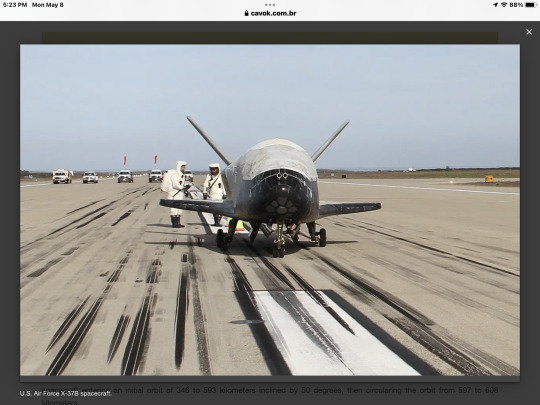
U.S. Air Force X-37B spacecraft.
This apparent second flight in the secret spacecraft differs from its first mission in 2020. This flight saw the space plane orbit for four days in an orbit of 331 to 347 kilometers inclined by 50 degrees. The recently completed mission lasted 276 days, with the spacecraft entering an initial orbit of 346 to 593 kilometers inclined by 50 degrees, then circularing the orbit from 597 to 608 kilometers.
The spacecraft performed numerous small and much larger orbital maneuvers during its flight, with adjustments made in recent weeks in preparation for landing.

The mysterious track near Lop Nor. (Photo: 2020 PLANET LABS)
It is likely that the landing took place at the military base of Lop Nur, in Xinjiang. Information about the spacecraft's orbit suggests that an orbital trail over the installation around 0020 UTC provided the opportunity for landing, according to Jonathan McDowell, astrophysicist and spaceflight activity tracker.
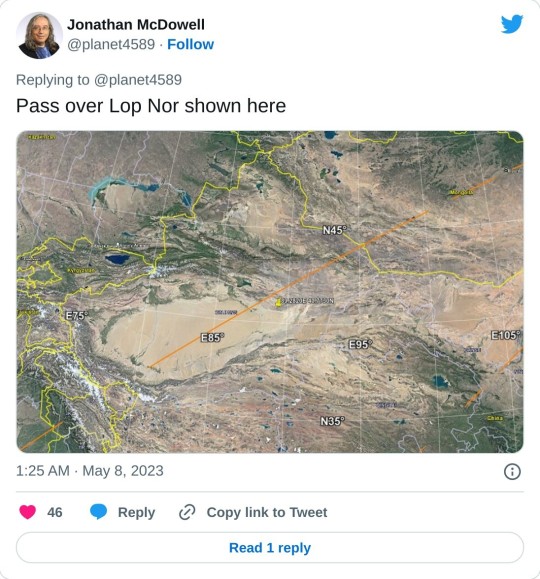
An image of an Umbra synthetic aperture radar satellite suggests recent activity at the Lop Nur site.
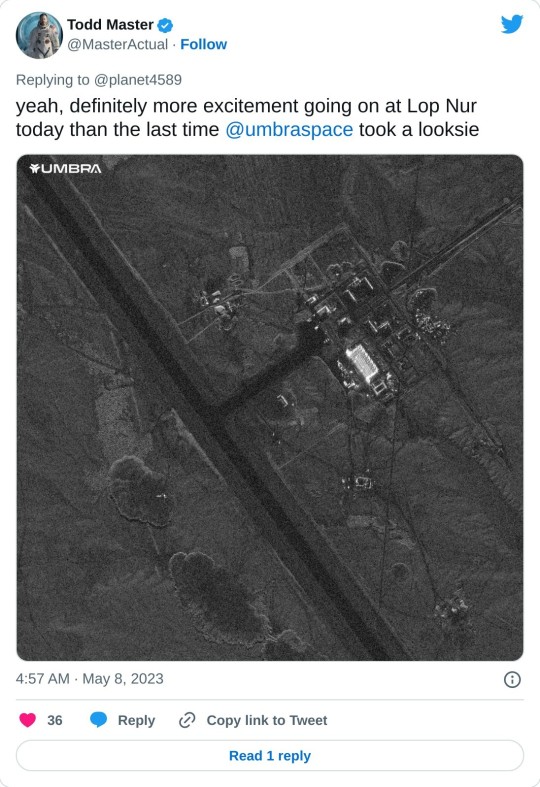
China has released little information about the project. The size and mass of the spacecraft are, however, limited by the use of the Long March 2F rocket, which can transport just over 8 tons to low Earth orbit.
Clues about the dimensions and shape of the ship appeared soon after launch, when apparent images of the cargo fairing for the mission appeared online.
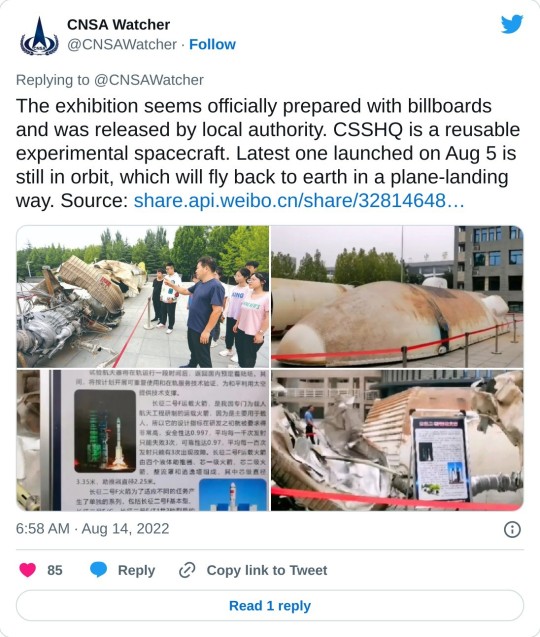
The spacecraft seems to be related to the development of an orbital segment of a two-stage space transport system for fully reusable orbit. A suborbital segment - with vertical takeoff and horizontal landing - had a second flight in September 2022.
The CASC reusable space plane project last year obtained national funding from the China Natural Sciences Foundation.
CASIC, a giant sister defense and space contractor, is working on her own space plane, called Tengyun.
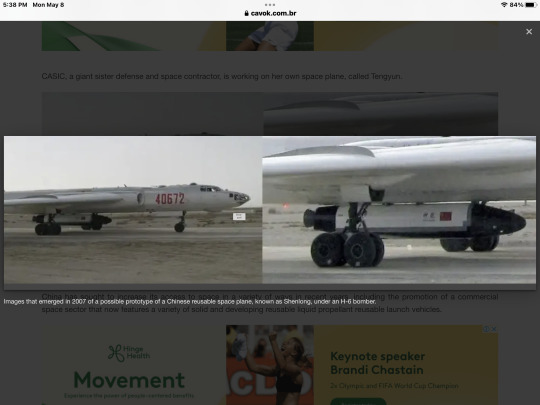
Images that emerged in 2007 of a possible prototype of a Chinese reusable space plane, known as Shenlong, under an H-6 bomber.
Meanwhile, a trading company called Space Transportation raised more than $46.3 million for its hypersonic spacecraft plans in 2021. Several Chinese rocket companies have also created presentations, including small space planes launched on liquid rocket concepts.
China has sought to increase its access to space in a variety of ways in recent years, including the promotion of a commercial space sector that now features a variety of solid and developing reusable liquid propellant reusable launch vehicles.
CASC, the country's main space contractor, is developing new super-heavy reusable launch vehicles that allow the country to try to land astronauts on the moon and a eventually fully reusable rocket to conduct large-scale space infrastructure missions.
Tags: ChinaSpace
Fernando Valduga
Fernando Valduga
Aviation photographer and pilot since 1992, has participated in several events and air operations, such as Cruzex, AirVenture, Daytona Airshow and FIDAE. He has works published in specialized aviation magazines in Brazil and abroad. Uses Canon equipment during his photographic work around the world of aviation.
Related news
COMMERCIAL
Russia continues to work on components for CR929
05/03/2023 - 11:00
SPACE
ViaSat-3 Americas is successfully launched
05/03/2023 - 06:00
SPACE
Virgin Galactic concludes gliding flight from Spaceport America
04/30/2023 - 11:20
HNA signed a contract for 60 single-aisle passenger jets C919 (photo) and 40 regional ARJ21 jets yesterday in Shanghai.
COMMERCIAL
COMAC sells 100 aircraft to Chinese airline
28/04/2023 - 10:00
SPACE
SpaceX tries again today the first launch of Starship
04/20/2023 - 09:00
SPACE
SpaceX aborts launch of the Starship rocket with a few minutes left
04/17/2023 - 19:25
homeMain PageEditorialsINFORMATIONeventsCooperateSpecialitiesadvertiseabout
Cavok Brazil - Digital Tchê Web Creation
Commercial
Executive
Helicopters
HISTORY
Military
Brazilian Air Force
Space
Specialities
Cavok Brazil - Digital Tchê Web Creation
4 notes
·
View notes
Text
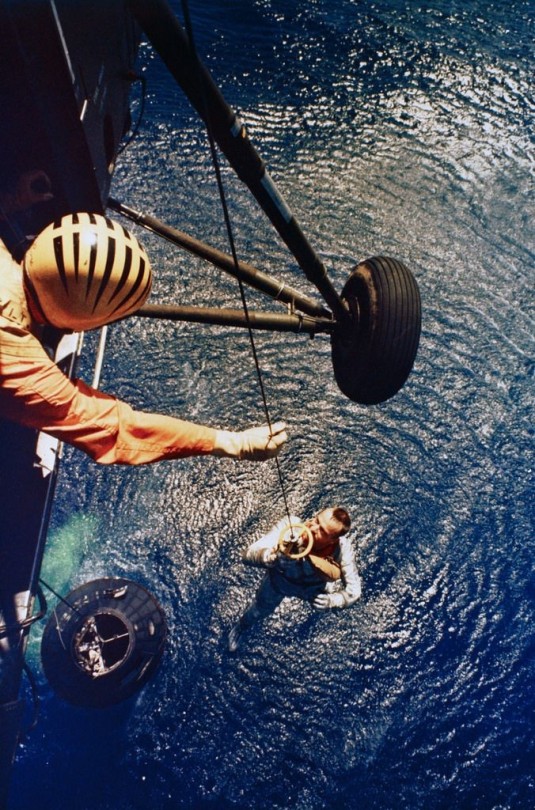
Astronaut Alan B. Shepard Jr., pilot of the Mercury-Redstone 3 (MR-3) suborbital spaceflight, is retrieved by a helicopter from the USS Lake Champlain during recovery operations in the western Atlantic Ocean. Source: flickr.com/photos/nasacommons
12 notes
·
View notes
Photo

Project Mercury was the first human-spaceflight program of the United States, running from 1958 through 1963. It was one of the first projects of NASA, which was created as a response to the Soviet Union's 1957 launch of Sputnik 1, the first satellite in Earth orbit. The program's goals were to orbit a crewed spacecraft around Earth, investigate the pilot's ability to function in space, and to recover both pilot and spacecraft safely. The Soviet Union won the race to put the first human into orbit when Yuri Gagarin traveled in Vostok 1 in 1961, while the US launched its first astronaut on a suborbital flight in the same year, and achieved crewed orbital flight in 1962 when John Glenn made three orbits around the Earth. The Mercury project's missions were followed by millions on radio and television around the world, and it laid the groundwork for Project Gemini, which carried two astronauts in each capsule and perfected space docking maneuvers essential for crewed lunar landings in the subsequent Apollo program, announced a few weeks after the first crewed Mercury flight. This NASA illustration compares the relative sizes and launch positions of the spacecraft and rockets of Project Mercury (small) with those of Gemini (medium) and Apollo (large).
Illustration credit: Davis Paul Meltzer
2 notes
·
View notes
Text
Irina: The Vampire Cosmonaut Volume 3 - Fly Me To The Moon

This third volume, a new story, something not adapted to an anime format yet, and something that I really need to give Kesiuke Makino credit for.

Let's take a short trip down what amounts to historical memory lane. Of course, Makino-sensei gets stuff like New Orleans down pat, and weaves a tough but considerately accurate and faithful picture of racism and discrimination of the era. So let's get the nitty gritty out of the way first.
Makino paints a very strong picture of segregation and discrimination, not just of the sentiment of "the other", but a systemic and foundational isolation of Dhampirs (in this story coming from full-blooded Vampires that immigrated to Arnack). The Moonlight District being an underdeveloped and under supported section of the somewhat fictional city of New Marseille, Dhampirs live in fear and constant poverty. Jobs opportunities are incredibly limited, wages are the bottom of the rung, and lynch mobs and supremacy groups roam the streets with a bloodlust.
It's a very bleak, and very faithful representation. They don't stop at "racism bad" or anything like that, they launch into full on descriptions, making sure that readers understand that members of the racial supremacist group of the novel are members of the community, are police officers and state troopers, are judges and political officials, and that they will abuse their power to abuse their position. It's willing to be realistic enough that it referenced historical events such as the 16th Street Baptist Church Bombing.
Of course, its representation of racial discrimination and tensions is more than even just the harrowing aspects of it. It sees the middle ground, the indifferent, the challenges of breaking down those walls, and of trying to pretend they don't even exist. As was the case with the first two volumes, this third volume represents an incredible amount of perspectives and ideals, and even touches upon aspects such as the perception of class traitors and self-imposed responsibility to your community.
It really is impressive how well they work with this stuff, though some might find it a little prickly at first as Makino integrates stuff like Jazz culture, funerals, and the French/Creole aspects of Black culture. But, credit at the minimum has to be given for the passion and accuracy that Makino treats it with. They find the brilliant aspects between the rough lines and allows them to shine brightly, but refuse to ignore the negative pieces.
I think that's just enough of the heavier side of things though, let's talk about the amazing pieces of history which Makino highlights in electric fashion. So, there's a group of women Dhampir in this story, that provide calculations via punch card computers using FORX (the fictional equivalent of BASIC), who work out of what's called the D-Room. I'm sure most people know of Margret Hamilton, who famously stood next to a massive pile of punch cards that are in part responsible for the moon landing, but what about NASA's human computers and some of their first programmers?
Well, those were also women, but even more than that they were African-American Women. Under the helm of Dorothy Vaughn, one of the Langley Center's first African-American managers, a team of (largely African-American) women came to be and provided incredible feats such as the calculations for the first suborbital spaceflight of the United States, the first orbital spaceflight, and even calculations for the moon landing of Apollo 11. These historical women are represented fictitiously here in this volume, and it's incredible to see (though I do wish Makino could compile their research notes to provide context and information to readers!).
The story is riddled with incredible references like this. Take the whole thing with Fly Me To The Moon, rather than it being the song that it is in our reality, it's now a science-fiction novel. More than that though, and something that I think has beautiful meaning in relation to the lead characters, is the name of the original artist for the song, Kaye Ballard. Our damphir protagonist carries the same first name, Kaye Scarlet. The content of the song, and the significance of the novel to both Kaye and Bart provides such a stunningly picturesque sense of romance. The beauty in the song that "Kaye" made being the reason that Bart fell in love with outer space is just such a wonderful piece.
Alongside that though there's other stuff that might be picked up on, like the Keighley Research Center vs the Langley Research Center, and so on and so forth.
Makino really does such an incredible job of telling impactful and important stories of history with such riveting fictional additions. Every moment has you tense, worried, excited, angry, laughing, smiling, and so on and so forth. It catches you off-guard with realizations and reveals, builds tension in the blink of an eye, and sells its characters incredibly well.
If there was one thing that this volume wanted to impart upon readers, it would be this. No matter where you are in the world, no matter what challenges or difficulties lay ahead of you, whether everyone or no one will support you, it's okay to dream. It's okay to aim for the stars, to look past what lays in front of you and express that passion, to chase after what lays in your heart. Even if people tell you that you can't do it, or that it's a weak or measly dream, or that they say it won't change anything or that it'd be a waste - dream.
Coming off the tail end of volume 2, and leading with a new story with fresh characters and concepts, Irina: The Vampire Cosmonaut volume 3 continues to stun and leave readers in awe at the quality and writing that Makino gives readers. Such an amazing science-fiction series that appeals to so many important pieces.
#tsuki to laika to nosferatu#Tsuki To Laika#Irina: The Vampire Cosmonaut#Irina The Vampire Cosmonaut#Kaye Scarlet#Bart Fiefield#light novel review#light novel recommendation#light novel
2 notes
·
View notes
Text
Simon Gwozdz: Equatorial Space’s Mission to Revolutionize Spaceflight with Propulsion Technology
Aerospace and Aviation made the landing on the moon possible by Neil Armstrong. We know astronomy, its research, and its exploration with the use of innovative solutions and technological instruments. We have come quite a long way in the scientific study of space, and there will be continuous research and development for better and improved solutions that will help us understand beyond what we already know.

In the Aerospace and Aviation industry like the well-known NASA, scientists, architects, researchers, engineers, etc work together for the government, companies, and organizations to make learning astronomy better with new and improved innovations. Therefore in this article, we discuss one such startup company in Singapore called Equatorial Space which aims to make spaceflights safer and affordable through rocket propulsion. Founded by Simon Gwozdz, Equatorial Space is rapidly gaining momentum.
Simon Gwozdz: Founder and CEO
Simon Gwozdz is an aspiring founder and CEO of Equatorial Space, which is Southeast Asia’s leading rocket propulsion company. He completed his graduation with a Bachelor of Science degree at the National University of Singapore and Arts education from Millennia Institute. He was a Motor Transport Operator at the Singapore Armed Forces (SAF) where he was responsible for safe, efficient, and timely transportation. Later his passion for this sector from childhood led him to start a space launch company.
Simon along with his co-founders thought of entering the New Space Field for some years where he was also learning science and engineering along with astronautics parallelly. He also connected with the local industry, and later the vision to make spaceflight affordable and safe he founded Equatorial Space in the year 2017.
About Equatorial Space
Equatorial Space is Southeast Asia’s leading rocket propulsion company founded in year 2017 by Simon Gwozdz. It has headquarters located in Singapore and aims to make spaceflight safer and affordable. The company launched its first commercially developed prototype of a rocket in the year 2020 which was built with highly differentiated technologies in challenging logistical settings.
The company has made different vehicle launchers that have unique features. Volans is a low-cost and convenient space launch vehicle that is designed with the capabilities of delivering 35-70 kg of payload which also depends on inclination. Volans is the first 100% pyrotechnics and explosives-free launcher that is built with the help of Equatorial Space’s innovative rocket propulsion technology. Next is Dorado which is a responsive launcher designed to deliver small payloads into a suborbital trajectory. It eliminates toxic effluents by producing small amounts of carbon and greenhouse gases. It is also designed to be 100% explosives-free and ships can be fully inert for easy deployment to any range in the world. The Spark (Student Payload Academic Rocket Kit) is the first rocket kit that was developed commercially with payload support for student training. It is 100% pyrotechnic-free and will allow students to conduct space experiments from design to launch.
The technology of HRF-1 fuel delivers high regression rates as well as excellent mechanical and structural properties. The HRF-1 offers structural stability, regression rates between 4-8mm/s, GHS reduction of up to 70%, and density of up to 1600kg/m3. All of these will provide quality and performance with the potential to make low-cost, safer space launchers.
The company has gained supporters and partners along their journey with the visionary goal. Some of them are elev*.vc, Seeds Capital, Farquhar Venture Capital, Space Zone India, aspace, etc. The company has received accolades and awards from the National Additive Manufacturing Innovation Cluster (NAMIC), Hello Tomorrow, and Mohammed Bin Rashid Space Centre. The incubators and accelerators for the company are sourced from techstars_, Q Stations, The Hangar, and the Space Accelerator Programme. Equatorial Space has been identified and propelled in the path to make spaceflights safer and more affordable with its unique rocket propulsion technologies.
Visit More : https://apacbusinesstimes.com/simon-gwozdz/
0 notes
Text
Soaring into the Future: Upcoming Trends in the Aviation Industry

The aviation industry has always been at the forefront of innovation, continually pushing the boundaries of technology and service. As we move further into the 21st century, several emerging trends are reshaping the landscape of aviation. From sustainable practices to digital transformation, let's explore some of the most exciting upcoming trends in the aviation industry.
Sustainable Aviation:
Environmental sustainability has become a top priority for the aviation industry. With increasing concerns about climate change and carbon emissions, airlines and manufacturers are investing heavily in sustainable aviation solutions. This includes the development of biofuels, electric aircraft, and carbon offset programs. In the coming years, we can expect to see a greater emphasis on eco-friendly practices throughout the aviation sector.
Digital Transformation:
Technology is revolutionizing every aspect of the aviation industry, from passenger experience to operational efficiency. Airlines are adopting advanced digital solutions such as mobile check-in, biometric identification, and AI-powered customer service bots. Additionally, big data analytics is being used to optimize flight routes, improve fuel efficiency, and enhance maintenance procedures. As digital transformation continues to unfold, air travel will become more seamless, personalized, and efficient.
Urban Air Mobility (UAM):
As urbanization accelerates and traffic congestion worsens in major cities, there is growing interest in urban air mobility solutions. Electric vertical takeoff and landing (eVTOL) aircraft, also known as flying taxis, are being developed to provide fast, efficient transportation within urban areas. Companies like Uber, Joby Aviation, and Volocopter are leading the charge in this emerging market. In the near future, we may see a network of aerial taxis operating in cities around the world, offering commuters a convenient alternative to traditional ground transportation.
Supersonic Travel:
After decades since the retirement of the Concorde, there is renewed interest in supersonic air travel. Several companies are developing next-generation supersonic jets capable of traveling faster than the speed of sound. These aircraft promise to significantly reduce travel times for long-haul flights, making the world more accessible than ever before. While regulatory and technical challenges remain, the dream of supersonic commercial air travel may soon become a reality.
Space Tourism:
Space tourism is poised to become the next frontier in the aviation industry. Companies like SpaceX, Blue Origin, and Virgin Galactic are working on commercial spaceflight ventures that aim to take paying customers on suborbital or orbital journeys beyond the Earth's atmosphere. As space technology advances and costs decline, space tourism could become a reality for a broader segment of the population in the coming years, opening up a whole new era of travel and exploration.
Conclusion:
The aviation industry is undergoing a period of rapid transformation, driven by technological innovation, environmental sustainability, and changing consumer preferences. From sustainable aviation practices to the rise of urban air mobility and the possibility of space tourism, the future of aviation holds immense promise and excitement. By embracing these upcoming trends, the aviation industry is poised to enter a new era of innovation, connectivity, and accessibility. By embracing these upcoming trends and investing in aviation training in Vadodara, individuals can become part of this dynamic industry's growth and evolution.
0 notes
Link
Los Angeles CA (SPX) Dec 21, 2023 In a significant step towards advancing space technology, NASA, in partnership with commercial spaceflight company Blue Origin, successfully conducted a suborbital flight test on December 19, 2023. The mission, part of NASA's Flight Opportunities program, propelled 14 research payloads towards future space missions and commercial applications. This collaboration signifies a concerted effort to t
0 notes
Text



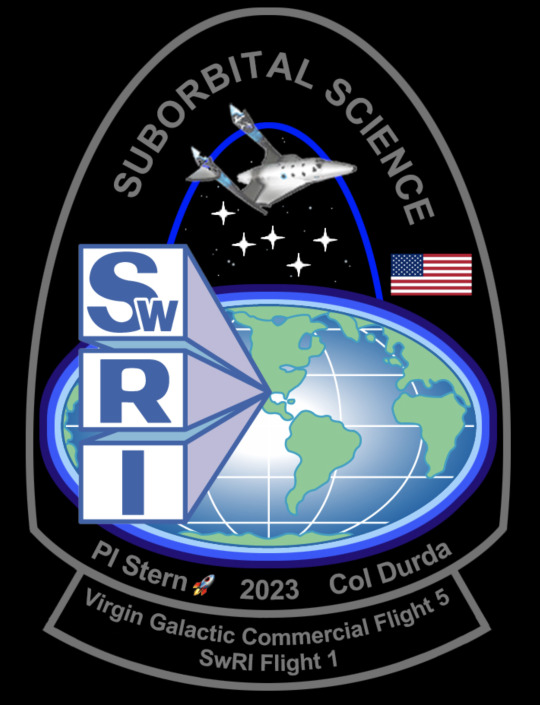

Another Virgin Galactic flight today, this time a research flight with three commercial sub-orbital astronauts onboard. Galactic 05 will be the 14th powered flight of VSS Unity which with take off onboard the carrier aircraft Eve at 14:30UT. However it won't be televised (as will be the norm in future, apparently multi-millionaires are shy). One of the passengers has still not been revealed but is a franco-italian. The other two are payload specialists.
Dr Alan Stern (pictured on left) is a US Planetary scientist and associate Vice President in Southwest Research Institutes (SwRI) space sector. He is best known as the principle investigator of the New Horizons Pluto mission and has played a key role in 30 sub-orbital, orbital and planetary space missions. He is also a former NASA Associate Administartor. He will be wearing a biomedical monitoring harness during the flight and conducting a dummy run for the operation of an astronomy camera.
Stern will wear a Accutracker-II biomedical harness, Various iterations of this have previously flown on 68 Space Shuttle missons and Stern has also worn it during F104 Starfighter research flights.
Dr Stern will also practice taking astronomical observations with a mock up Xybion wide angle visible and UV camera, for which he is principle investigator. This has also previously flown on two Space Shuttle missions. The real camera will be flown on a future flight, under NASA's Flight Opportunities program, for which Dr Stern will be practicing.
Kelli Gerardi is a US Bioastronautics Researcher from the International Institute for Astronautical Sciences (IIAS). She is operations lead for Palantir Technologies. She will be wearing a boimedical monitoring shirt and conducting payload experiments developed with the National Research Council of Canada (NRC). She has also previously conducted an expedition to the analog Mars Desert Research Station and is an online presenter. She is the authour of 'Not Necessarily Rocket Science' and the childrens picture book series 'Luna Muna."
During the flight Gerardi will wear and Asrtoskin, developed by IIAS, a biomonitoring lightweight shirt which has an all in one sensor suite developed by Candadian company Carré Technologies and the Canadian Space Agency (CSA). It has an electrocardiogram which will monitor heart rate, breathing rate and temperature throughout all phases of the flight. The shirt is also used by astonauts while onboard the ISS.
She will also conduct the IIAS experiment 'Configuration of a Confined Fluid in a Low Gravity Enviroment'. Gerardi will operate a fluid cell designed to better help predict and control the shape and location of fluid within a container in microgravity. This data can help inform the design of life-support systems and new medical syringe designs.
Finally Gerardi will 'deploy' an implantable sensor that can continuously sample blood glucose levels and record them in the IIAS experiment 'Contiunous Blood Glucoose Monitoring in Suborbital Flight'. There is growing evidence that long duration spaceflight induces insulin resistance, a pre-diabetic state. This will offer insights, it is hoped, as to how quickly insulin-resitance develops during spaceflight. This will be one of the first uses of a glucose monitor in a microgravity enviroment.
The next Virgin Galactic flight, Galactic 06, will be in January 2024. Rival Blue Origin is set to resume New Shepard flights (with a new booster), following an FAA investigation, on 30 November after booster NS4 suffered an engine failure on Flight NS-23, in September 2022, triggering the capsule to fire it's launch escape motor. Fortunately it was a research flight with no crew onboard. This upcoming flight is also an uncrewed research flight to check all is well with the new booster.
youtube
0 notes
Photo


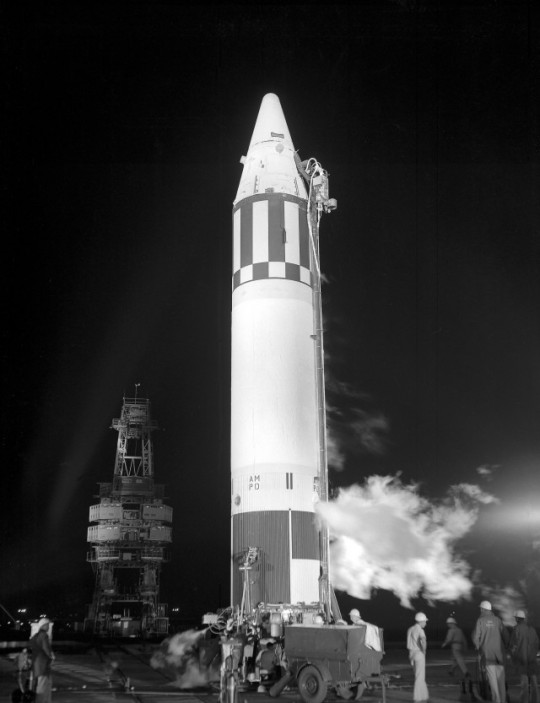

May 28, 1959: Female monkeys Able and Baker become the first primates to survive spaceflight.
A rhesus macaque named Able and a squirrel monkey named Baker launched on a suborbital flight aboard a Jupiter rocket. They were the first primates (and animals other than dogs) to survive spaceflight, but Able died a few days later during surgery. Baker spent the rest of her days at the US Space & Rocket Center in Huntsville, Alabama where she entertained visitors and received more than a hundred fan letters a day. She died in 1987 and the age of 27, setting the record for the oldest squirrel monkey to ever live.
Read more about Able, Baker, and other primates who flew in space here!
24 notes
·
View notes